NRSG258 - Kathleen Johnson: Obesity, Surgery, and Nursing Management
VerifiedAdded on 2023/06/14
|8
|2604
|296
Case Study
AI Summary
This case study focuses on Kathleen Johnson, a 45-year-old obese patient with type 2 diabetes, who undergoes sleeve gastrectomy surgery. It details her history, including being the sole caregiver for her father with dementia and her unhealthy coping mechanisms like excessive drinking and smoking. The case study analyzes her post-operative vital signs, including elevated respiration and blood pressure, low temperature and urine output, and high pain score, relating them to her pre-existing conditions and lifestyle. It discusses the causes and effects of obesity, the rationale behind the surgical intervention, and potential nursing interventions, including balanced nutrition and psychological support. The importance of an interdisciplinary health team, involving physicians, social workers, and case managers, is highlighted to ensure comprehensive care for obese patients like Kathleen. The study concludes by emphasizing the dangers of obesity and the significance of preventative measures like diet and physical fitness.

Running head: KATHLEEN OBESITY 1
Kathleen Obesity
Student’s name
Institution name
Kathleen Obesity
Student’s name
Institution name
Paraphrase This Document
Need a fresh take? Get an instant paraphrase of this document with our AI Paraphraser
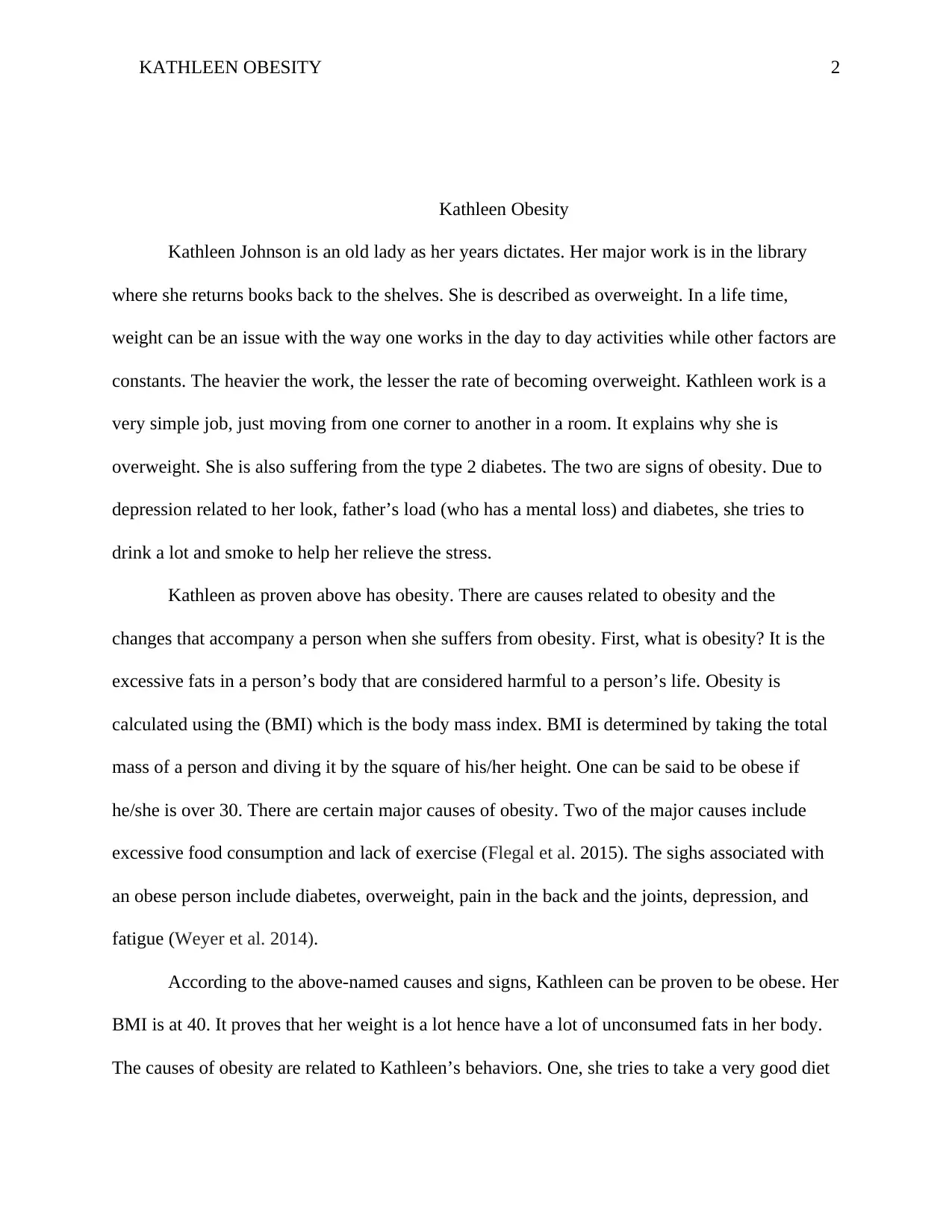
KATHLEEN OBESITY 2
Kathleen Obesity
Kathleen Johnson is an old lady as her years dictates. Her major work is in the library
where she returns books back to the shelves. She is described as overweight. In a life time,
weight can be an issue with the way one works in the day to day activities while other factors are
constants. The heavier the work, the lesser the rate of becoming overweight. Kathleen work is a
very simple job, just moving from one corner to another in a room. It explains why she is
overweight. She is also suffering from the type 2 diabetes. The two are signs of obesity. Due to
depression related to her look, father’s load (who has a mental loss) and diabetes, she tries to
drink a lot and smoke to help her relieve the stress.
Kathleen as proven above has obesity. There are causes related to obesity and the
changes that accompany a person when she suffers from obesity. First, what is obesity? It is the
excessive fats in a person’s body that are considered harmful to a person’s life. Obesity is
calculated using the (BMI) which is the body mass index. BMI is determined by taking the total
mass of a person and diving it by the square of his/her height. One can be said to be obese if
he/she is over 30. There are certain major causes of obesity. Two of the major causes include
excessive food consumption and lack of exercise (Flegal et al. 2015). The sighs associated with
an obese person include diabetes, overweight, pain in the back and the joints, depression, and
fatigue (Weyer et al. 2014).
According to the above-named causes and signs, Kathleen can be proven to be obese. Her
BMI is at 40. It proves that her weight is a lot hence have a lot of unconsumed fats in her body.
The causes of obesity are related to Kathleen’s behaviors. One, she tries to take a very good diet
Kathleen Obesity
Kathleen Johnson is an old lady as her years dictates. Her major work is in the library
where she returns books back to the shelves. She is described as overweight. In a life time,
weight can be an issue with the way one works in the day to day activities while other factors are
constants. The heavier the work, the lesser the rate of becoming overweight. Kathleen work is a
very simple job, just moving from one corner to another in a room. It explains why she is
overweight. She is also suffering from the type 2 diabetes. The two are signs of obesity. Due to
depression related to her look, father’s load (who has a mental loss) and diabetes, she tries to
drink a lot and smoke to help her relieve the stress.
Kathleen as proven above has obesity. There are causes related to obesity and the
changes that accompany a person when she suffers from obesity. First, what is obesity? It is the
excessive fats in a person’s body that are considered harmful to a person’s life. Obesity is
calculated using the (BMI) which is the body mass index. BMI is determined by taking the total
mass of a person and diving it by the square of his/her height. One can be said to be obese if
he/she is over 30. There are certain major causes of obesity. Two of the major causes include
excessive food consumption and lack of exercise (Flegal et al. 2015). The sighs associated with
an obese person include diabetes, overweight, pain in the back and the joints, depression, and
fatigue (Weyer et al. 2014).
According to the above-named causes and signs, Kathleen can be proven to be obese. Her
BMI is at 40. It proves that her weight is a lot hence have a lot of unconsumed fats in her body.
The causes of obesity are related to Kathleen’s behaviors. One, she tries to take a very good diet
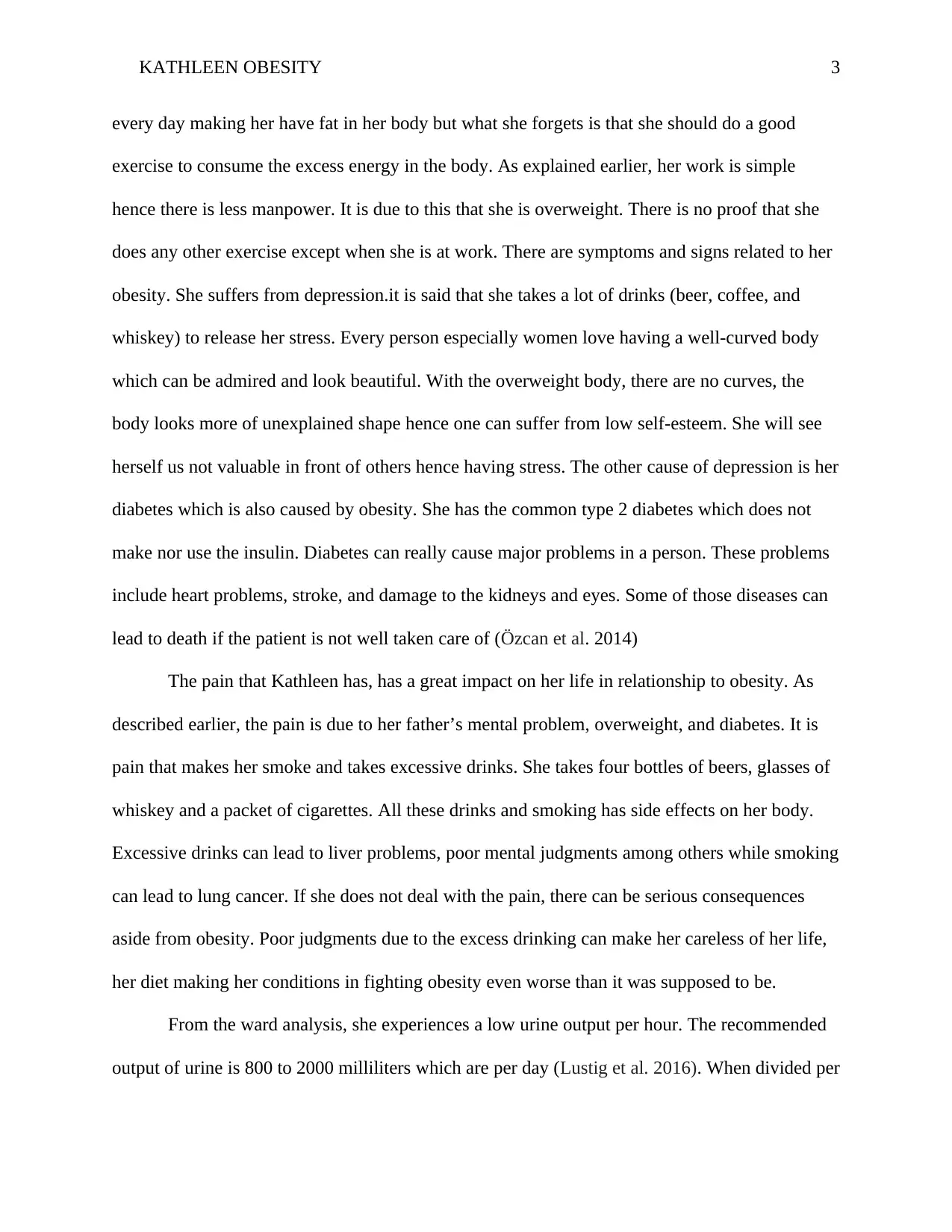
KATHLEEN OBESITY 3
every day making her have fat in her body but what she forgets is that she should do a good
exercise to consume the excess energy in the body. As explained earlier, her work is simple
hence there is less manpower. It is due to this that she is overweight. There is no proof that she
does any other exercise except when she is at work. There are symptoms and signs related to her
obesity. She suffers from depression.it is said that she takes a lot of drinks (beer, coffee, and
whiskey) to release her stress. Every person especially women love having a well-curved body
which can be admired and look beautiful. With the overweight body, there are no curves, the
body looks more of unexplained shape hence one can suffer from low self-esteem. She will see
herself us not valuable in front of others hence having stress. The other cause of depression is her
diabetes which is also caused by obesity. She has the common type 2 diabetes which does not
make nor use the insulin. Diabetes can really cause major problems in a person. These problems
include heart problems, stroke, and damage to the kidneys and eyes. Some of those diseases can
lead to death if the patient is not well taken care of (Özcan et al. 2014)
The pain that Kathleen has, has a great impact on her life in relationship to obesity. As
described earlier, the pain is due to her father’s mental problem, overweight, and diabetes. It is
pain that makes her smoke and takes excessive drinks. She takes four bottles of beers, glasses of
whiskey and a packet of cigarettes. All these drinks and smoking has side effects on her body.
Excessive drinks can lead to liver problems, poor mental judgments among others while smoking
can lead to lung cancer. If she does not deal with the pain, there can be serious consequences
aside from obesity. Poor judgments due to the excess drinking can make her careless of her life,
her diet making her conditions in fighting obesity even worse than it was supposed to be.
From the ward analysis, she experiences a low urine output per hour. The recommended
output of urine is 800 to 2000 milliliters which are per day (Lustig et al. 2016). When divided per
every day making her have fat in her body but what she forgets is that she should do a good
exercise to consume the excess energy in the body. As explained earlier, her work is simple
hence there is less manpower. It is due to this that she is overweight. There is no proof that she
does any other exercise except when she is at work. There are symptoms and signs related to her
obesity. She suffers from depression.it is said that she takes a lot of drinks (beer, coffee, and
whiskey) to release her stress. Every person especially women love having a well-curved body
which can be admired and look beautiful. With the overweight body, there are no curves, the
body looks more of unexplained shape hence one can suffer from low self-esteem. She will see
herself us not valuable in front of others hence having stress. The other cause of depression is her
diabetes which is also caused by obesity. She has the common type 2 diabetes which does not
make nor use the insulin. Diabetes can really cause major problems in a person. These problems
include heart problems, stroke, and damage to the kidneys and eyes. Some of those diseases can
lead to death if the patient is not well taken care of (Özcan et al. 2014)
The pain that Kathleen has, has a great impact on her life in relationship to obesity. As
described earlier, the pain is due to her father’s mental problem, overweight, and diabetes. It is
pain that makes her smoke and takes excessive drinks. She takes four bottles of beers, glasses of
whiskey and a packet of cigarettes. All these drinks and smoking has side effects on her body.
Excessive drinks can lead to liver problems, poor mental judgments among others while smoking
can lead to lung cancer. If she does not deal with the pain, there can be serious consequences
aside from obesity. Poor judgments due to the excess drinking can make her careless of her life,
her diet making her conditions in fighting obesity even worse than it was supposed to be.
From the ward analysis, she experiences a low urine output per hour. The recommended
output of urine is 800 to 2000 milliliters which are per day (Lustig et al. 2016). When divided per
⊘ This is a preview!⊘
Do you want full access?
Subscribe today to unlock all pages.

Trusted by 1+ million students worldwide
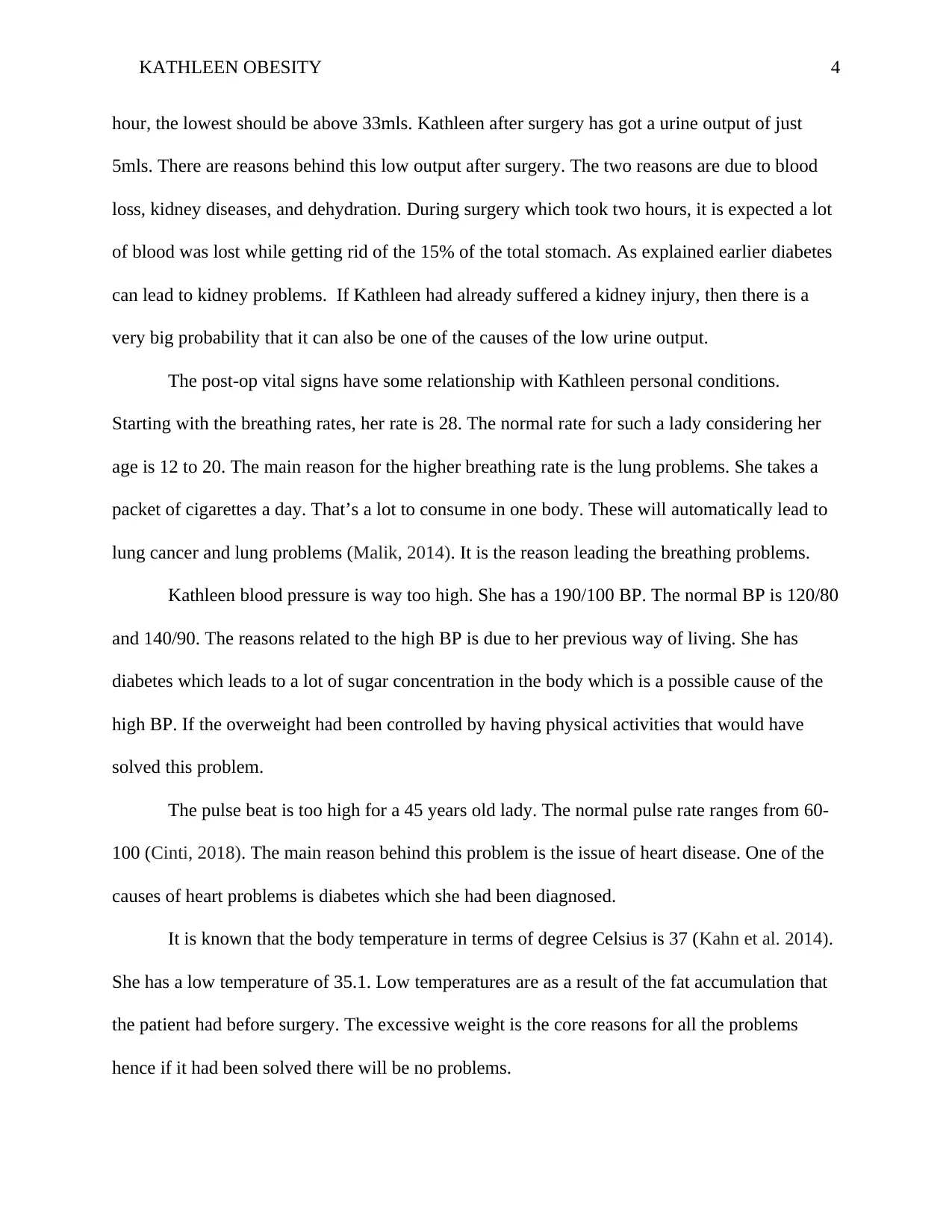
KATHLEEN OBESITY 4
hour, the lowest should be above 33mls. Kathleen after surgery has got a urine output of just
5mls. There are reasons behind this low output after surgery. The two reasons are due to blood
loss, kidney diseases, and dehydration. During surgery which took two hours, it is expected a lot
of blood was lost while getting rid of the 15% of the total stomach. As explained earlier diabetes
can lead to kidney problems. If Kathleen had already suffered a kidney injury, then there is a
very big probability that it can also be one of the causes of the low urine output.
The post-op vital signs have some relationship with Kathleen personal conditions.
Starting with the breathing rates, her rate is 28. The normal rate for such a lady considering her
age is 12 to 20. The main reason for the higher breathing rate is the lung problems. She takes a
packet of cigarettes a day. That’s a lot to consume in one body. These will automatically lead to
lung cancer and lung problems (Malik, 2014). It is the reason leading the breathing problems.
Kathleen blood pressure is way too high. She has a 190/100 BP. The normal BP is 120/80
and 140/90. The reasons related to the high BP is due to her previous way of living. She has
diabetes which leads to a lot of sugar concentration in the body which is a possible cause of the
high BP. If the overweight had been controlled by having physical activities that would have
solved this problem.
The pulse beat is too high for a 45 years old lady. The normal pulse rate ranges from 60-
100 (Cinti, 2018). The main reason behind this problem is the issue of heart disease. One of the
causes of heart problems is diabetes which she had been diagnosed.
It is known that the body temperature in terms of degree Celsius is 37 (Kahn et al. 2014).
She has a low temperature of 35.1. Low temperatures are as a result of the fat accumulation that
the patient had before surgery. The excessive weight is the core reasons for all the problems
hence if it had been solved there will be no problems.
hour, the lowest should be above 33mls. Kathleen after surgery has got a urine output of just
5mls. There are reasons behind this low output after surgery. The two reasons are due to blood
loss, kidney diseases, and dehydration. During surgery which took two hours, it is expected a lot
of blood was lost while getting rid of the 15% of the total stomach. As explained earlier diabetes
can lead to kidney problems. If Kathleen had already suffered a kidney injury, then there is a
very big probability that it can also be one of the causes of the low urine output.
The post-op vital signs have some relationship with Kathleen personal conditions.
Starting with the breathing rates, her rate is 28. The normal rate for such a lady considering her
age is 12 to 20. The main reason for the higher breathing rate is the lung problems. She takes a
packet of cigarettes a day. That’s a lot to consume in one body. These will automatically lead to
lung cancer and lung problems (Malik, 2014). It is the reason leading the breathing problems.
Kathleen blood pressure is way too high. She has a 190/100 BP. The normal BP is 120/80
and 140/90. The reasons related to the high BP is due to her previous way of living. She has
diabetes which leads to a lot of sugar concentration in the body which is a possible cause of the
high BP. If the overweight had been controlled by having physical activities that would have
solved this problem.
The pulse beat is too high for a 45 years old lady. The normal pulse rate ranges from 60-
100 (Cinti, 2018). The main reason behind this problem is the issue of heart disease. One of the
causes of heart problems is diabetes which she had been diagnosed.
It is known that the body temperature in terms of degree Celsius is 37 (Kahn et al. 2014).
She has a low temperature of 35.1. Low temperatures are as a result of the fat accumulation that
the patient had before surgery. The excessive weight is the core reasons for all the problems
hence if it had been solved there will be no problems.
Paraphrase This Document
Need a fresh take? Get an instant paraphrase of this document with our AI Paraphraser
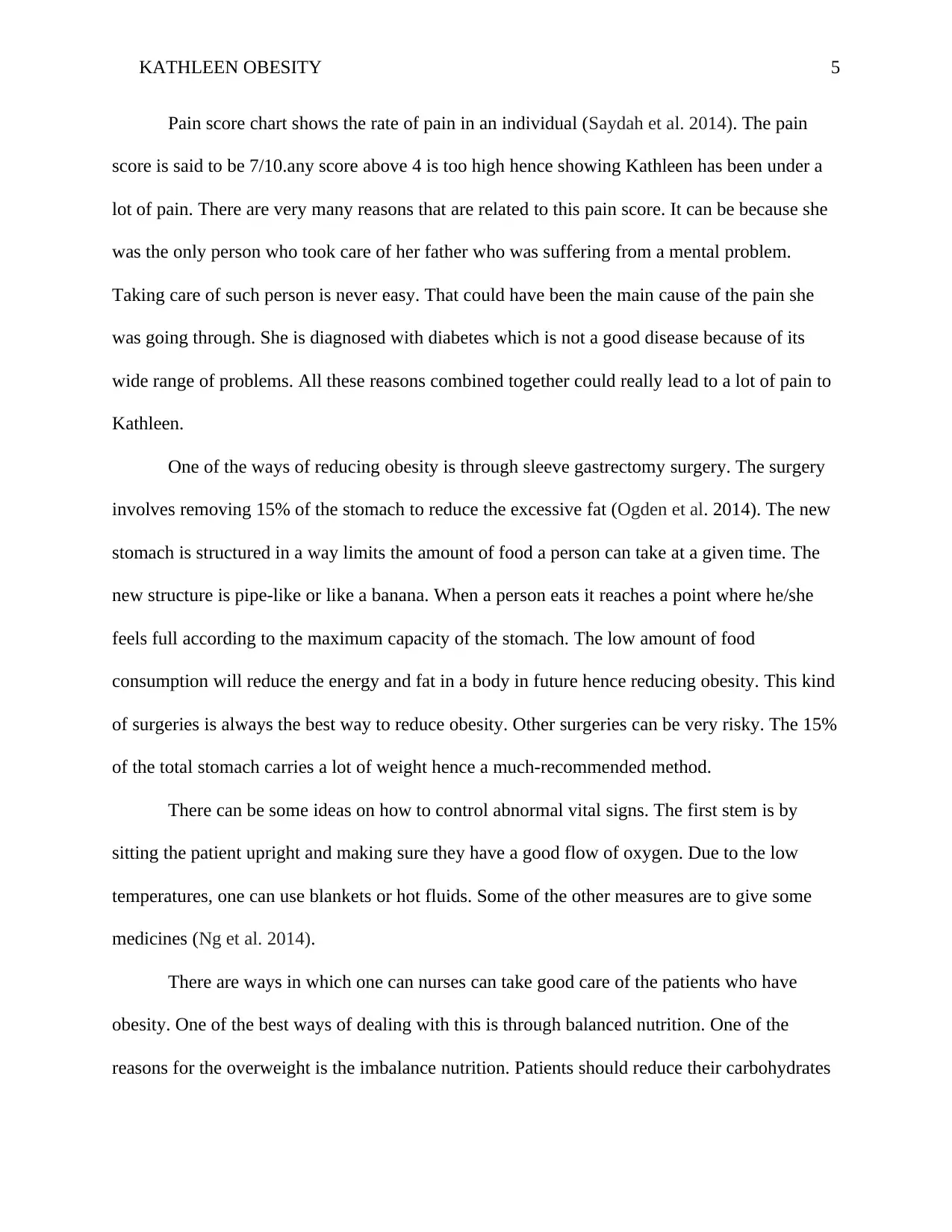
KATHLEEN OBESITY 5
Pain score chart shows the rate of pain in an individual (Saydah et al. 2014). The pain
score is said to be 7/10.any score above 4 is too high hence showing Kathleen has been under a
lot of pain. There are very many reasons that are related to this pain score. It can be because she
was the only person who took care of her father who was suffering from a mental problem.
Taking care of such person is never easy. That could have been the main cause of the pain she
was going through. She is diagnosed with diabetes which is not a good disease because of its
wide range of problems. All these reasons combined together could really lead to a lot of pain to
Kathleen.
One of the ways of reducing obesity is through sleeve gastrectomy surgery. The surgery
involves removing 15% of the stomach to reduce the excessive fat (Ogden et al. 2014). The new
stomach is structured in a way limits the amount of food a person can take at a given time. The
new structure is pipe-like or like a banana. When a person eats it reaches a point where he/she
feels full according to the maximum capacity of the stomach. The low amount of food
consumption will reduce the energy and fat in a body in future hence reducing obesity. This kind
of surgeries is always the best way to reduce obesity. Other surgeries can be very risky. The 15%
of the total stomach carries a lot of weight hence a much-recommended method.
There can be some ideas on how to control abnormal vital signs. The first stem is by
sitting the patient upright and making sure they have a good flow of oxygen. Due to the low
temperatures, one can use blankets or hot fluids. Some of the other measures are to give some
medicines (Ng et al. 2014).
There are ways in which one can nurses can take good care of the patients who have
obesity. One of the best ways of dealing with this is through balanced nutrition. One of the
reasons for the overweight is the imbalance nutrition. Patients should reduce their carbohydrates
Pain score chart shows the rate of pain in an individual (Saydah et al. 2014). The pain
score is said to be 7/10.any score above 4 is too high hence showing Kathleen has been under a
lot of pain. There are very many reasons that are related to this pain score. It can be because she
was the only person who took care of her father who was suffering from a mental problem.
Taking care of such person is never easy. That could have been the main cause of the pain she
was going through. She is diagnosed with diabetes which is not a good disease because of its
wide range of problems. All these reasons combined together could really lead to a lot of pain to
Kathleen.
One of the ways of reducing obesity is through sleeve gastrectomy surgery. The surgery
involves removing 15% of the stomach to reduce the excessive fat (Ogden et al. 2014). The new
stomach is structured in a way limits the amount of food a person can take at a given time. The
new structure is pipe-like or like a banana. When a person eats it reaches a point where he/she
feels full according to the maximum capacity of the stomach. The low amount of food
consumption will reduce the energy and fat in a body in future hence reducing obesity. This kind
of surgeries is always the best way to reduce obesity. Other surgeries can be very risky. The 15%
of the total stomach carries a lot of weight hence a much-recommended method.
There can be some ideas on how to control abnormal vital signs. The first stem is by
sitting the patient upright and making sure they have a good flow of oxygen. Due to the low
temperatures, one can use blankets or hot fluids. Some of the other measures are to give some
medicines (Ng et al. 2014).
There are ways in which one can nurses can take good care of the patients who have
obesity. One of the best ways of dealing with this is through balanced nutrition. One of the
reasons for the overweight is the imbalance nutrition. Patients should reduce their carbohydrates
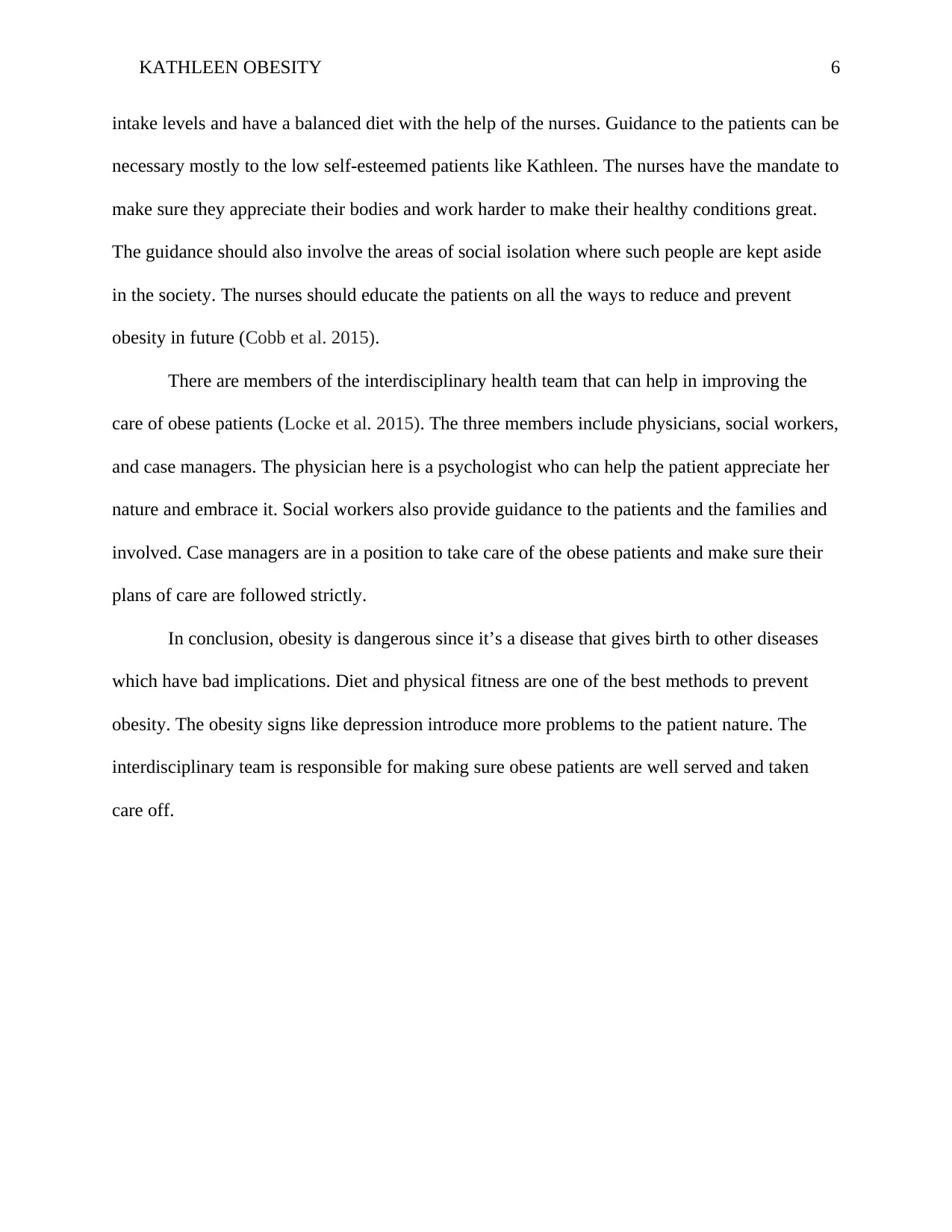
KATHLEEN OBESITY 6
intake levels and have a balanced diet with the help of the nurses. Guidance to the patients can be
necessary mostly to the low self-esteemed patients like Kathleen. The nurses have the mandate to
make sure they appreciate their bodies and work harder to make their healthy conditions great.
The guidance should also involve the areas of social isolation where such people are kept aside
in the society. The nurses should educate the patients on all the ways to reduce and prevent
obesity in future (Cobb et al. 2015).
There are members of the interdisciplinary health team that can help in improving the
care of obese patients (Locke et al. 2015). The three members include physicians, social workers,
and case managers. The physician here is a psychologist who can help the patient appreciate her
nature and embrace it. Social workers also provide guidance to the patients and the families and
involved. Case managers are in a position to take care of the obese patients and make sure their
plans of care are followed strictly.
In conclusion, obesity is dangerous since it’s a disease that gives birth to other diseases
which have bad implications. Diet and physical fitness are one of the best methods to prevent
obesity. The obesity signs like depression introduce more problems to the patient nature. The
interdisciplinary team is responsible for making sure obese patients are well served and taken
care off.
intake levels and have a balanced diet with the help of the nurses. Guidance to the patients can be
necessary mostly to the low self-esteemed patients like Kathleen. The nurses have the mandate to
make sure they appreciate their bodies and work harder to make their healthy conditions great.
The guidance should also involve the areas of social isolation where such people are kept aside
in the society. The nurses should educate the patients on all the ways to reduce and prevent
obesity in future (Cobb et al. 2015).
There are members of the interdisciplinary health team that can help in improving the
care of obese patients (Locke et al. 2015). The three members include physicians, social workers,
and case managers. The physician here is a psychologist who can help the patient appreciate her
nature and embrace it. Social workers also provide guidance to the patients and the families and
involved. Case managers are in a position to take care of the obese patients and make sure their
plans of care are followed strictly.
In conclusion, obesity is dangerous since it’s a disease that gives birth to other diseases
which have bad implications. Diet and physical fitness are one of the best methods to prevent
obesity. The obesity signs like depression introduce more problems to the patient nature. The
interdisciplinary team is responsible for making sure obese patients are well served and taken
care off.
⊘ This is a preview!⊘
Do you want full access?
Subscribe today to unlock all pages.

Trusted by 1+ million students worldwide
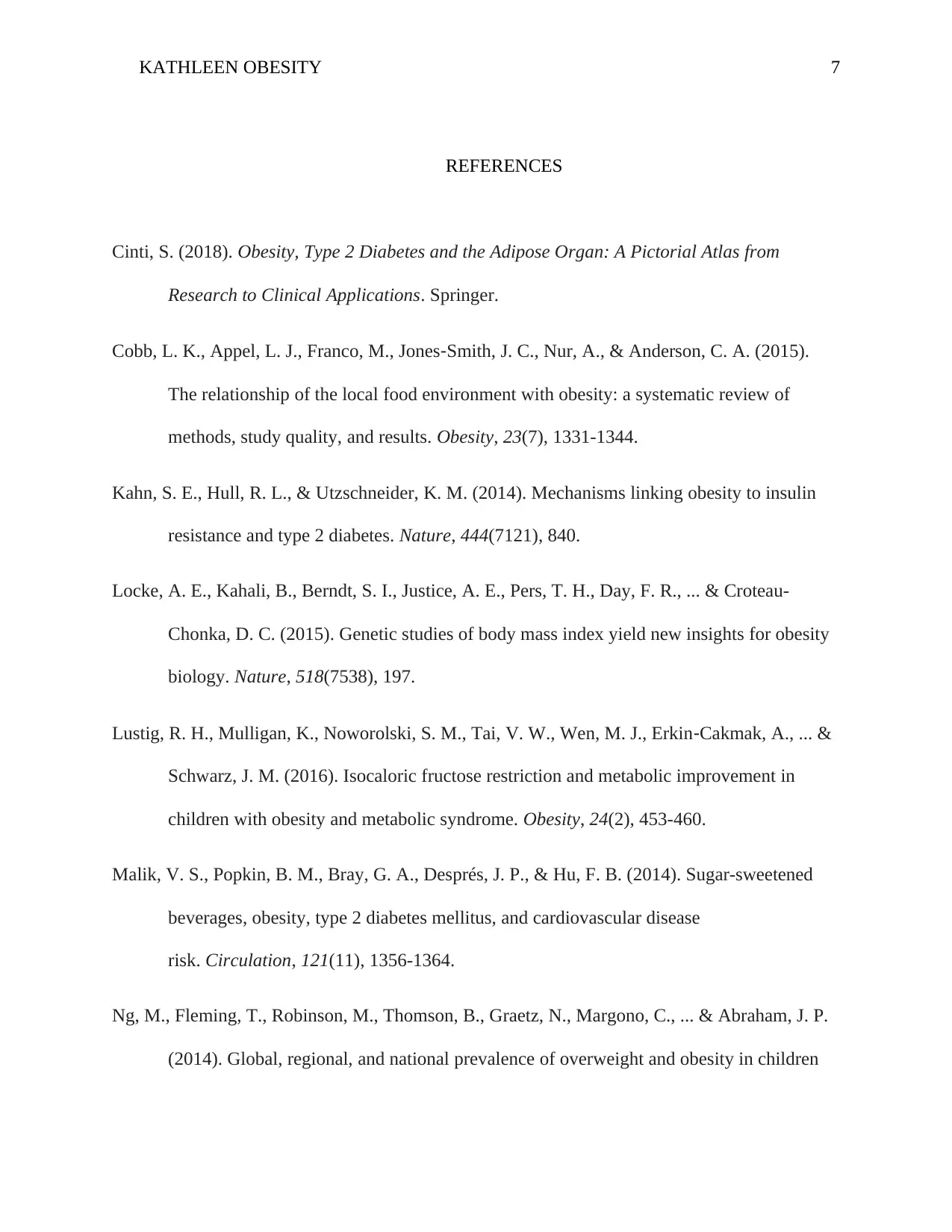
KATHLEEN OBESITY 7
REFERENCES
Cinti, S. (2018). Obesity, Type 2 Diabetes and the Adipose Organ: A Pictorial Atlas from
Research to Clinical Applications. Springer.
Cobb, L. K., Appel, L. J., Franco, M., Jones‐Smith, J. C., Nur, A., & Anderson, C. A. (2015).
The relationship of the local food environment with obesity: a systematic review of
methods, study quality, and results. Obesity, 23(7), 1331-1344.
Kahn, S. E., Hull, R. L., & Utzschneider, K. M. (2014). Mechanisms linking obesity to insulin
resistance and type 2 diabetes. Nature, 444(7121), 840.
Locke, A. E., Kahali, B., Berndt, S. I., Justice, A. E., Pers, T. H., Day, F. R., ... & Croteau-
Chonka, D. C. (2015). Genetic studies of body mass index yield new insights for obesity
biology. Nature, 518(7538), 197.
Lustig, R. H., Mulligan, K., Noworolski, S. M., Tai, V. W., Wen, M. J., Erkin‐Cakmak, A., ... &
Schwarz, J. M. (2016). Isocaloric fructose restriction and metabolic improvement in
children with obesity and metabolic syndrome. Obesity, 24(2), 453-460.
Malik, V. S., Popkin, B. M., Bray, G. A., Després, J. P., & Hu, F. B. (2014). Sugar-sweetened
beverages, obesity, type 2 diabetes mellitus, and cardiovascular disease
risk. Circulation, 121(11), 1356-1364.
Ng, M., Fleming, T., Robinson, M., Thomson, B., Graetz, N., Margono, C., ... & Abraham, J. P.
(2014). Global, regional, and national prevalence of overweight and obesity in children
REFERENCES
Cinti, S. (2018). Obesity, Type 2 Diabetes and the Adipose Organ: A Pictorial Atlas from
Research to Clinical Applications. Springer.
Cobb, L. K., Appel, L. J., Franco, M., Jones‐Smith, J. C., Nur, A., & Anderson, C. A. (2015).
The relationship of the local food environment with obesity: a systematic review of
methods, study quality, and results. Obesity, 23(7), 1331-1344.
Kahn, S. E., Hull, R. L., & Utzschneider, K. M. (2014). Mechanisms linking obesity to insulin
resistance and type 2 diabetes. Nature, 444(7121), 840.
Locke, A. E., Kahali, B., Berndt, S. I., Justice, A. E., Pers, T. H., Day, F. R., ... & Croteau-
Chonka, D. C. (2015). Genetic studies of body mass index yield new insights for obesity
biology. Nature, 518(7538), 197.
Lustig, R. H., Mulligan, K., Noworolski, S. M., Tai, V. W., Wen, M. J., Erkin‐Cakmak, A., ... &
Schwarz, J. M. (2016). Isocaloric fructose restriction and metabolic improvement in
children with obesity and metabolic syndrome. Obesity, 24(2), 453-460.
Malik, V. S., Popkin, B. M., Bray, G. A., Després, J. P., & Hu, F. B. (2014). Sugar-sweetened
beverages, obesity, type 2 diabetes mellitus, and cardiovascular disease
risk. Circulation, 121(11), 1356-1364.
Ng, M., Fleming, T., Robinson, M., Thomson, B., Graetz, N., Margono, C., ... & Abraham, J. P.
(2014). Global, regional, and national prevalence of overweight and obesity in children
Paraphrase This Document
Need a fresh take? Get an instant paraphrase of this document with our AI Paraphraser
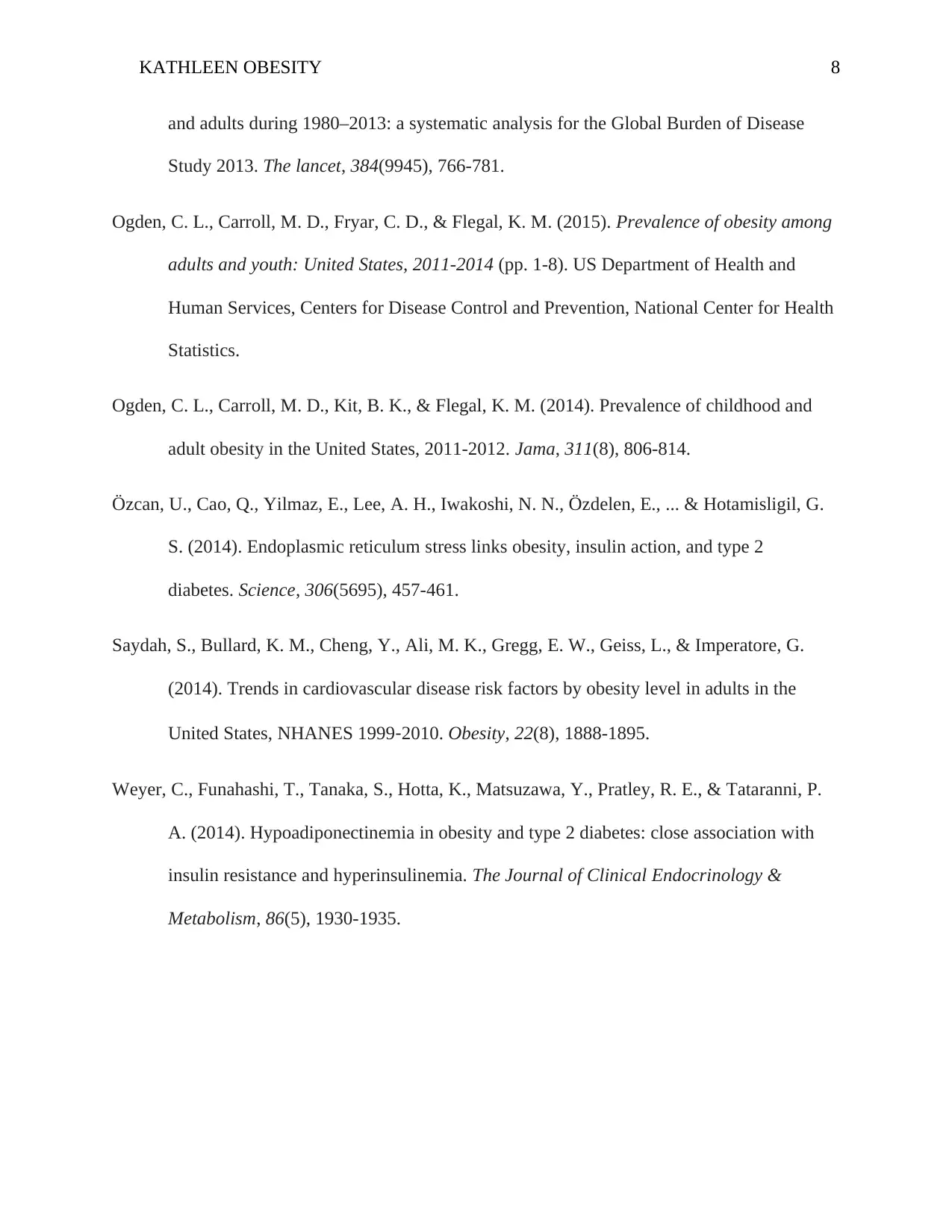
KATHLEEN OBESITY 8
and adults during 1980–2013: a systematic analysis for the Global Burden of Disease
Study 2013. The lancet, 384(9945), 766-781.
Ogden, C. L., Carroll, M. D., Fryar, C. D., & Flegal, K. M. (2015). Prevalence of obesity among
adults and youth: United States, 2011-2014 (pp. 1-8). US Department of Health and
Human Services, Centers for Disease Control and Prevention, National Center for Health
Statistics.
Ogden, C. L., Carroll, M. D., Kit, B. K., & Flegal, K. M. (2014). Prevalence of childhood and
adult obesity in the United States, 2011-2012. Jama, 311(8), 806-814.
Özcan, U., Cao, Q., Yilmaz, E., Lee, A. H., Iwakoshi, N. N., Özdelen, E., ... & Hotamisligil, G.
S. (2014). Endoplasmic reticulum stress links obesity, insulin action, and type 2
diabetes. Science, 306(5695), 457-461.
Saydah, S., Bullard, K. M., Cheng, Y., Ali, M. K., Gregg, E. W., Geiss, L., & Imperatore, G.
(2014). Trends in cardiovascular disease risk factors by obesity level in adults in the
United States, NHANES 1999‐2010. Obesity, 22(8), 1888-1895.
Weyer, C., Funahashi, T., Tanaka, S., Hotta, K., Matsuzawa, Y., Pratley, R. E., & Tataranni, P.
A. (2014). Hypoadiponectinemia in obesity and type 2 diabetes: close association with
insulin resistance and hyperinsulinemia. The Journal of Clinical Endocrinology &
Metabolism, 86(5), 1930-1935.
and adults during 1980–2013: a systematic analysis for the Global Burden of Disease
Study 2013. The lancet, 384(9945), 766-781.
Ogden, C. L., Carroll, M. D., Fryar, C. D., & Flegal, K. M. (2015). Prevalence of obesity among
adults and youth: United States, 2011-2014 (pp. 1-8). US Department of Health and
Human Services, Centers for Disease Control and Prevention, National Center for Health
Statistics.
Ogden, C. L., Carroll, M. D., Kit, B. K., & Flegal, K. M. (2014). Prevalence of childhood and
adult obesity in the United States, 2011-2012. Jama, 311(8), 806-814.
Özcan, U., Cao, Q., Yilmaz, E., Lee, A. H., Iwakoshi, N. N., Özdelen, E., ... & Hotamisligil, G.
S. (2014). Endoplasmic reticulum stress links obesity, insulin action, and type 2
diabetes. Science, 306(5695), 457-461.
Saydah, S., Bullard, K. M., Cheng, Y., Ali, M. K., Gregg, E. W., Geiss, L., & Imperatore, G.
(2014). Trends in cardiovascular disease risk factors by obesity level in adults in the
United States, NHANES 1999‐2010. Obesity, 22(8), 1888-1895.
Weyer, C., Funahashi, T., Tanaka, S., Hotta, K., Matsuzawa, Y., Pratley, R. E., & Tataranni, P.
A. (2014). Hypoadiponectinemia in obesity and type 2 diabetes: close association with
insulin resistance and hyperinsulinemia. The Journal of Clinical Endocrinology &
Metabolism, 86(5), 1930-1935.
1 out of 8
Related Documents
Your All-in-One AI-Powered Toolkit for Academic Success.
+13062052269
info@desklib.com
Available 24*7 on WhatsApp / Email
![[object Object]](/_next/static/media/star-bottom.7253800d.svg)
Unlock your academic potential
Copyright © 2020–2025 A2Z Services. All Rights Reserved. Developed and managed by ZUCOL.





